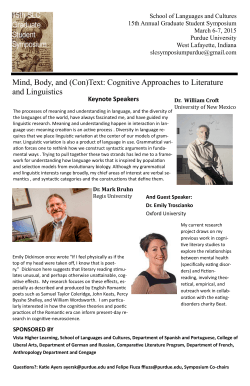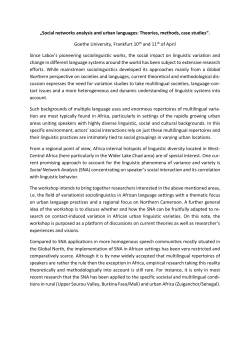
The attention-coherence model of prominence: A look at "now
The attention-coherence model of prominence: A look at "now" D. Altshuler and U. Stojnic According to the simple hypothesis, dating back to Kaplan (1989) and Kamp (1971), now, like I, is a pure indexical—an expression who’s linguistic meaning fully determines the referent on an occasion of use. Where the two expressions differ is in their linguistic meaning: I picks out the speaker, whereas now picks out the utterance time. The simple hypothesis is motivated by the following data: 1. Anne is happy now. 2. I learned last week that there would now be an earthquake. (Kamp 1971) 3. #The sun now stood above the hippodrome. The simple hypothesis cannot, however, account for the following discourses: 4. Victoria began to look nervous, thought Jenya. She was shaking and paced back and forth. Apparently, she learned last week that there would now be an earthquake (Altshuler 2009). 5. Pilate raised his martyred eyes to the prisoner and saw how high the sun now stood above the hippodrome, how a ray had penetrated the arcade …(The Master and Margarita). 6. John came home. #Now he wrote a letter. (Kamp & Reyle 1993). 7. I like to think back on the summer of ’97. #I was so happy now. (Hunter 2012). In (4)-(5), now co-occurs with the past tense and does not pick out the utterance time. (6)(7) show past reference with now is not always possible when embedded in a discourse. As argued by Dry (1979) and Hunter (2010), now’s past reference is not due to context shifting or literary devices such as Free Indirect Discourse. In our talk, we argue that while the simple hypothesis gets the main insight right – now really is a pure indexical – it posits the wrong linguistic meaning. The meaning of now is not linked to a time, but rather to the most prominent state, e.g. the ongoing state of the conversation in (1)-(2), and the post-state of an event in (4)-(5). Of course, to provide testable predictions, and explain the infelicity of (6)-(7), we need an account of prominence. Stojnic et al. (2014) provide such an account, which we refer to as the attentioncoherence model. They consider how the context gets antecedently set up in order for the interpretation of demonstrative pronouns (like he) to work in an automatic fashion. Key to their analysis is the idea that the context-setting is done by a range of linguistic mechanisms affecting (among other things) the relative prominence of candidate referents at a given point in a discourse. This allows Stojnic et al. to treat demonstrative pronouns as pure indexicals. In the talk, we show how Stojnic et al.’s analysis can account for the now data above. Crucial to our analysis is treating coherence relations as linguistic conventions (treated as updates) and not pragmatic principles; the choice of the coherence relation determines the resolution of a context sensitive expression (such as now) by affecting the prominence ranking of candidate referents. In a nutshell, we propose that (a) the interpretation of now is fully determined by its linguistic meaning as a function of context, where (b) now refers to the most prominent state, and (c) prominence is determined by the attentioncoherence model. The punch line is that an insightful account of prominence can be given by appealing to a set of linguistic conventions and not as a byproduct of pragmatic reasoning.
© Copyright 2025












